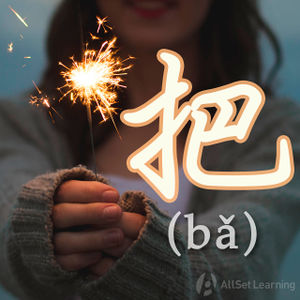Difference between revisions of "Verbs followed by "gei""
| Line 1: | Line 1: | ||
{{Grammar Box}} | {{Grammar Box}} | ||
| − | |||
| + | Although it's standard practice to put a word or phrase that modifies a verb ''before'' the verb, there are, of course, exceptions. 给 (gěi) is one of those exceptions; it sometimes comes before the verb, and sometimes after. (For this reason, there is some academic debate over whether this 给 is actually a preposition or a type of verb, but we won't get into that....) This article is about when it comes after. | ||
| − | + | == Basic Pattern == | |
| − | == Structure == | + | === Structure === |
| + | Note that the verbs that fit into this pattern are normally single-syllable verbs. | ||
<div class="jiegou"> | <div class="jiegou"> | ||
| Line 13: | Line 14: | ||
</div> | </div> | ||
| − | == Examples == | + | === Examples === |
<div class="liju"> | <div class="liju"> | ||
| Line 30: | Line 31: | ||
* 一 个 小孩 <em>交给</em> 了 我 一 封 信。 | * 一 个 小孩 <em>交给</em> 了 我 一 封 信。 | ||
| + | </div> | ||
| − | + | == Pattern Using 把 == | |
| − | + | === Structure === | |
<div class="jiegou"> | <div class="jiegou"> | ||
| − | Subject + 把 + Object + | + | Subject + 把 + Object + Verb + 给 + somebody |
</div> | </div> | ||
| + | |||
| + | === Examples === | ||
<div class="liju"> | <div class="liju"> | ||
| Line 56: | Line 60: | ||
</div> | </div> | ||
| − | + | === Exception to the 把 Pattern: 嫁 === | |
| + | |||
| + | Note that the verb 嫁 (jià) cannot fit into the 把 pattern above; it's an exception. | ||
<div class="liju"> | <div class="liju"> | ||
| Line 64: | Line 70: | ||
</div> | </div> | ||
| − | + | If you really really want to make a 把 sentence, though, you can do this: | |
<div class="liju"> | <div class="liju"> | ||
Revision as of 02:19, 8 August 2014
-
Level
-
Similar to
-
Used for
-
Keywords
Although it's standard practice to put a word or phrase that modifies a verb before the verb, there are, of course, exceptions. 给 (gěi) is one of those exceptions; it sometimes comes before the verb, and sometimes after. (For this reason, there is some academic debate over whether this 给 is actually a preposition or a type of verb, but we won't get into that....) This article is about when it comes after.
Contents
Basic Pattern
Structure
Note that the verbs that fit into this pattern are normally single-syllable verbs.
Subject + Verb + 给 + [Recipient] + Object
Examples
- 他 送给 了 我 一 束 花。
- 这 个 老板 卖给 了 我 一 条 死 鱼。
- 我 要 还给 你 三 十 块 钱。
- 房东 租给 了 我 一 个 很 便宜 的 房子。
- 我 借给 了 他 一 本 书。
- 我 要 糖,他 递给 了 我 一 瓶 盐。
- 姐姐 分给 了 我 一块 蛋糕。
- 老师 传授给 了 学生 很多 经验。
- 我们 献给 了 老师 一 首 歌。
- 这些 校友 捐给 了 学校 二 十 万。
- 主人 赏给 了 小狗 一 块 肉。
- 一 个 小孩 交给 了 我 一 封 信。
Pattern Using 把
Structure
Subject + 把 + Object + Verb + 给 + somebody
Examples
- 他 把 一 束 花 送给 了 我。
- 这 个 老板 把 一 条 死鱼 卖给 了 我。
- 房东 把 一 个 很 便宜 的 房子 租给 了 我。
- 我 把 一 本 书 借给 了 他。
- 我 要 糖,他 把 一 瓶 盐 递给 了 我。
- 姐姐 把 一 块 蛋糕 分给 了 我。
- 老师 把 很 多 经验 传授给 了 学生。
- 我们 把 一 首 歌 献给 了 老师。
- 这 些 校友 把 二 十 万 捐给 了 学校。
- 主人 把 一 块 肉 赏给 了 小狗。
- 一 个 小孩 把 一 封 信 交给 了 我。
Exception to the 把 Pattern: 嫁
Note that the verb 嫁 (jià) cannot fit into the 把 pattern above; it's an exception.
- 她 嫁给 了 一 个 有 钱 的 老头。
If you really really want to make a 把 sentence, though, you can do this:
- 她 的 爸爸 把 她 嫁给 了 一 个 有 钱 的 老头。
See also
Sources and further reading
Books
Dictionaries
- 现代汉语词典(第5版) (p. 464) →buy



